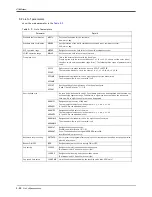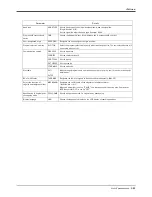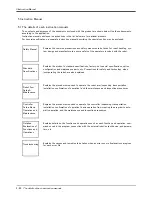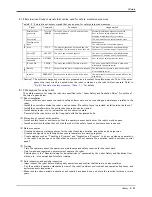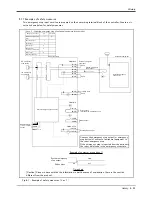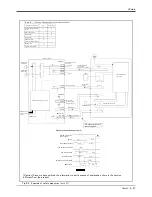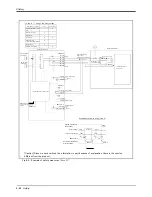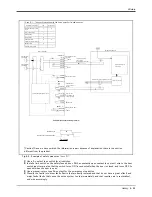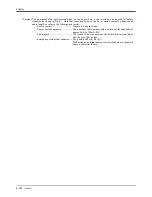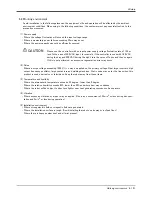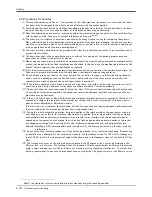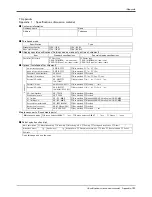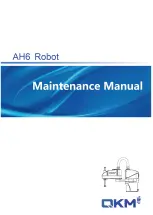
6-102
Precautions for handling
6Safety
6.3 Precautions for handling
(1) This robot has brakes on all axes. The precision of the robot may drop, looseness may occur and the reduc
-
tion gears may be damaged if the robot is moved with force with the brakes applied.
(2) Avoid moving the robot arm by hand. When unavoidable, gradually move the arm. If moved suddenly, the accu
-
racy may drop due to an excessive backlash, or the backed up data may be destroyed.
(3) Note that depending on the posture, even when within the movement range, the wrist section could interfere
with the base section. Take care to prevent interference during jog.
Note1)
(4) The robot arm is configured of precision parts such as bearings. Grease is used for lubricating these parts.
When cold starting at low temperatures or starting operation after long-term stoppage, the position accuracy
may drop or servo alarms may occur. If these problems occur, perform a 5 to 10 minute running-in operation at
a low speed (about a half of normal operating speed).
(5) The robot arm and controller must be grounded with Class D grounding to secure the noise resistance and to
prevent electric shocks.
(6) The items described in these specifications are conditions for carrying out the periodic maintenance and
inspections described in the instruction manual.
(7) When using the robot arm on a mobile axis or elevating table, the machine cables enclosed as standard config
-
uration may break due to the fixed installation specifications. In this case, use the machine cable extension (for
flexed)" factory shipment special specifications or options.
(8) If this robot interferes with the workpiece or peripheral devices during operation, the position may deviate, etc.
Take care to prevent interference with the workpiece or peripheral devices during operation.
(9) Do not attach a tape or a label to the robot arm and the controller. If a tape or a label with strong adhesive
power, such as a packaging tape, is attached to the coated surfaces of the robot arm and controller, the
coated surface may be damaged when such tape or label is peeled off.
(10) If the robot is operated with a heavy load and at a high speed, the surface of the robot arm gets very hot. It
would not result in burns, however, it may cause secondary accidents if touched carelessly.
(11) Do not shut down the input power supply to stop the robot. If the power supply is frequently shut down during
a heavy load or high-speed operation, the speed reducer may be damaged, backlash may occur, and the pro
-
gram data may be destroyed.
(12) If the J1, J2 and J3 axes collide with the mechanical stopper during the automatic operation of the robot, it is
necessary to replace the resin part of the mechanical stopper unit. For the replacement of the resin parts,
please contact Mitsubishi or Mitsubishi's dealer.
If the resin part is not replaced, the mechanism unit and the speed reducer may be damaged significantly when
the axes collide with the mechanical stopper next or subsequent time.
(13) During the robot's automatic operation, a break is applied to the robot arm when the input power supply is
shut down by a power failure, for instance. When a break is applied, the arm may deviate from the operation
path predetermined by automatic operation and, as a result, it may interfere with the mechanical stopper
depending on the operation at shutdown. In such a case, take an appropriate measure in advance to prevent
any dangerous situation from occurring due to the interference between the arm and peripheral devices.
Example) Installing a UPS (uninterruptible power supply unit) to the primary power source in order to reduce
interference.
(14) Do not conduct an insulated voltage test. If conducted by mistake, it may result in a breakdown. If conducting
an insulation test, although it is not covered by warranty, set the leakage current to 100 mA. If a leakage cur
-
rent of 10 mA is set, a low measurement value will be shown due to the leakage current of the built-in AC line
filter.
(15) The fretting may occur on the axis which moving angle is the 30 degree or less, or moving distance is the
30mm or less, or not moves. The fretting is that the required oil film becomes hard to be formed if the moving
angle is small, and wear occurs. The axis which not moved is moving slightly by vibration etc. To prevent the
fretting, recommends to move these axes about once every day the 30 degree or more, or the 30mm or more.
Note1) Jog operation refers to operating the robot manually using the teaching pendant.

